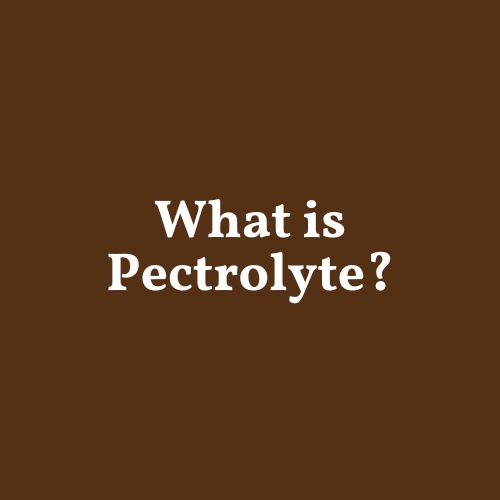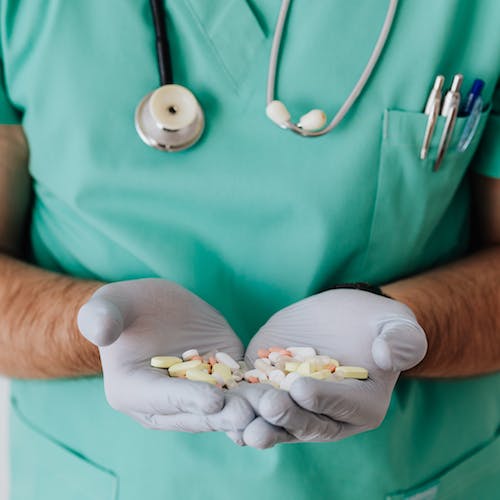Pectrolyte is a multifunctional medication used to treat various medical conditions, including diarrhoea, gastrointestinal reflux disease, diabetes, and electrolyte imbalance.
This medicine operates by absorbing surplus fluids, regulating intestinal movement, and bulking up stools. It is crucial to confer with a medical professional before utilising Pectrolyte and to be cognisant of potential adverse effects such as bloating and diarrhoea.

Introduction to Pectrolyte
Pectrolyte, a widely used medication, addresses several conditions such as diarrhoea, gastroesophageal reflux disease (GERD), diabetes, high levels of triglycerides, electrolyte imbalance, low calcium levels, high cholesterol levels, and relief from symptoms of dry oozing and weeping poison ivy or oak.
This suspension is a combination of active ingredients including Chlorodyne, Kaolin Pectin, Potassium Chloride, Sodium Chloride, and Sodium Lactate.
These components collectively absorb surplus fluid in the body while controlling intestinal movement. They also bind substances within the intestine, adding bulk to stools, thereby helping to regulate bowel movements.
Medical advice is paramount before starting Pectrolyte Suspension, especially if you have any pre-existing health conditions or are taking other medications.
This will ensure it does not interfere with any ongoing treatments or cause adverse effects when combined with existing medications.
Common side effects may include bloating, diarrhoea, decrease in appetite, stomach pain, swelling, nausea, and vomiting. It is essential to store it at room temperature away from heat and direct light to maintain its efficacy over time.
Understanding Pectrolyte
Pectrolyte is a frequently used medication for treating a range of conditions. It is available as a suspension and contains several active ingredients, each with its specific function.
What is Pectrolyte?
Pectrolyte Suspension is an oral solution crafted to replace fluids and minerals lost due to diarrhoea and vomiting. It is instrumental in preventing or treating dehydration, which can be detrimental to the body’s normal functioning.
Active Ingredients in Pectrolyte
The active ingredients present in Pectroltye include:
- Chlorodyne: This ingredient works by absorbing surplus fluid from within your intestines.
- Kaolin: Known for its binding properties, kaolin binds substances present in your intestine.
- Pectin: Pectin aids digestion by adding bulk to stools while reducing intestinal movement.
- Potassium Chloride: Potassium chloride replenishes electrolytes lost during episodes such as diarrhoea or vomiting.
- Sodium Lactate: Sodium lactate plays a crucial role in increasing blood volume.
Common Conditions Treated with Pectrolyte
- Diarrhoea
- Gastroesophageal reflux disease (GERD)
- Diabetes management
- Regulation of high triglycerides levels
- Correction of electrolyte imbalance
- Maintenance of low calcium levels
- Control of high cholesterol levels
- Relief for dry oozing, weeping poison ivy, and poison oak
Before using Pectrolyte Suspension, it’s always advisable to consult a medical professional, especially if you have any pre-existing health conditions or are taking other medications.
How does Pectrolyte work?
Understanding how Pectrolyte works can help us appreciate its effectiveness in treating various ailments.
1. Absorption of excess fluid
One of the primary functions of Pectrolyte is the absorption of excess fluids present in the body, particularly in cases such as diarrhoea and vomiting. It helps prevent dehydration and restores the balance of essential electrolytes lost during these episodes.
2. Reduction of intestinal movement
Pectrolyte operates by reducing excessive intestinal movements or motility caused by certain gastrointestinal disorders like gastroesophageal reflux disease (GERD). This reduction aids in alleviating discomfort and frequent trips to the bathroom.
3. Binding substances in the intestine
Pectrolyte contains Kaolin and Sodium Lactate that have binding properties within the intestines. These substances bind harmful toxins or irritants in our digestive system, preventing their absorption into our bloodstream while facilitating their elimination from our bodies via stool formation.
4. Adding bulk to stools
In addition to binding substances, Pectrolyte increases stool volume without causing constipation-like effects commonly seen with other medications used for similar purposes. This is primarily due to its composition containing pectin – a soluble fibre derived from fruits.
5. Increasing blood volume
Potassium Chloride, Sodium Chloride, and Sodium lactate are among Pectrolyte’s components. These elements play an important role in maintaining proper hydration levels throughout your body.
They increase blood volume, ensuring adequate circulation and delivery of nutrients and oxygen where they’re needed most.
In conclusion, Pectrolyte works through a combination of mechanisms to address various conditions.
Its ability to absorb excess fluid, reduce intestinal movement, bind substances in the intestine, add bulk to stools, and increase blood volume makes it an effective medication for treating diarrhoea, gastroesophageal reflux disease, dry oozing, weeping poison ivy, and other related ailments.
However, it is important to consult with your doctor before using this product to ensure its suitability based on individual health circumstances.
Uses and Benefits of Pectrolyte
Pectrolyte is a versatile medication with several uses and benefits for various conditions. Here are some common applications:
Treatment of Diarrhoea
Pectrolyte is primarily used in the treatment of diarrhoea. It works by absorbing excess fluid in the intestines, reducing intestinal movement, and adding bulk to stools. This helps alleviate symptoms such as frequent loose or watery bowel movements.
Management of Gastroesophageal Reflux Disease (GERD)
Pectrolyte can also be used to manage gastroesophageal reflux disease, commonly known as GERD. By binding substances in the intestine, it reduces acid production and provides relief from heartburn caused by stomach acid flowing back into the esophagus.
Support for Diabetes Management
For individuals with diabetes who experience fluctuations in blood sugar levels due to vomiting or diarrhoea episodes, Pectrolyte can help maintain electrolyte balance while replenishing fluids lost during these episodes.
Regulation Of High Triglyceride Levels
High triglyceride levels pose risks to cardiovascular health; however, Pectrolyte may aid regulation when combined with lifestyle changes like diet modification. Pectrolyte contains active ingredients such as potassium chloride which supports healthy lipid metabolism leading to reduced triglyceride levels over time.
Correction Of Electrolyte Imbalance
Electrolyte imbalance occurs when there’s an abnormality in mineral concentration within body fluids. This condition could result from excessive sweating, vomiting, or diarrhoea.
Incorporating Pectrolyte solution aids restoration of normal electrolytic equilibrium by providing essential minerals like sodium, potassium, and calcium which play vital roles in nerve function, muscle contraction, and maintaining proper hydration status.
Maintenance Of Calcium Levels
Calcium plays a crucial role not only in bone formation but also in muscle contractions, blood clotting, and nerve function. Pectrolyte contains sodium lactate which helps maintain calcium levels within the body, ensuring optimal functioning of these essential processes.
Control Of High Cholesterol Levels
High cholesterol is a common health concern that can lead to various cardiovascular problems. Pectrolyte’s active ingredients such as pectin have been found to help control high cholesterol levels by binding bile acids in the intestine, preventing their reabsorption into the bloodstream.
Relief For Dry Oozing, Weeping Poison Ivy And Poison Oak
Pectrolyte suspension has also shown effectiveness in providing relief for skin conditions like dry oozing or weeping poison ivy and poison oak rashes. The medication works by reducing inflammation and soothing irritated skin areas when applied topically.
In conclusion, Pectrolyte offers multiple uses and benefits across different medical conditions. Its ability to treat diarrhoea, gastroesophageal reflux disease, and support diabetes management makes it an effective solution for gastrointestinal issues.
Additionally, it aids regulation of triglyceride levels, electrolyte balance, maintenance of calcium levels within the body, and controlling high cholesterol. Furthermore, the topical application provides relief for certain dermatological conditions like poison ivy and oak rashes.
However, before using this medication, it is always advisable to consult with a healthcare professional to determine if it is suitable for your specific condition.
Related
How to use Pectrolyte
Dosage instructions
The dosage of Pectrolyte will vary depending on the individual’s medical condition and response to treatment.
It is important to follow the recommended dosage provided by your doctor or as indicated on the product package. Do not exceed the prescribed dose unless directed by a healthcare professional.
Oral administration
- Pectrolyte is taken orally, either in liquid or powdered form. Follow the instructions for preparation and consumption carefully.
- For liquid forms, shake well before using and measure out the appropriate amount using a measuring device provided with the medication or as instructed by your pharmacist.
- If you are taking powdered form, mix it thoroughly with water according to package directions before consuming.
Liquid and powdered forms
Pectrolyte comes in both liquid suspension and powder formulations. Both have their advantages:
- Liquid Suspension
- Ready-to-use formulation that does not require any additional mixing
- Convenient for immediate consumption during episodes of diarrhoea or vomiting
- Powdered Formulation
- Can be stored easily without refrigeration until needed
- Provides flexibility in terms of adjusting concentration based on individual needs
Consultation with a doctor
It is crucial to consult a healthcare professional before starting any new medication regimen, including Pectrolyte usage.
Your doctor can provide personalised advice regarding proper dosing based on your specific health conditions such as diabetes, electrolytic imbalances, etc., potential interactions with other medications you may be taking, and duration/timing considerations related specifically to your case.
Duration of treatment
The length of time one should take Pectrolyte depends upon several factors like underlying cause(s), severity of symptoms, and overall progress made over the course of treatment.
It is important to complete the full course as prescribed by the doctor even though symptoms may improve before completion. Failure to do so may result in recurrence of symptoms or complications.
Side effects of Pectrolyte
Pectrolyte is generally considered safe and well-tolerated. However, like any medication, it may cause some side effects in certain individuals. It’s important to be aware of these potential side effects before using Pectrolyte.
Common Side Effects
- Bloating: Some people may experience bloating or a feeling of fullness after taking Pectrolyte. This can occur due to the absorption of excess fluid by the medication.
- Diarrhoea: One common side effect reported with the use of Pectrolyte is diarrhoea. This could be a result of increased intestinal movement caused by the active ingredients present in this suspension.
- Decreased appetite: In some cases, users have reported a decrease in appetite while taking Pectrolyte Suspension. This temporary loss of interest in food should resolve once you stop using this product.
- Stomach pain or swelling: Stomach discomfort such as pain or swelling has been observed as another possible adverse reaction associated with Pectrolyte’s usage. If you experience severe stomach pain that persists for an extended period, consult your doctor immediately.
- Nausea: Nausea refers to feelings of unease and discomfort in the stomach, often accompanied by an urge to vomit. While rare, some individuals may experience nausea as a side effect of Pectrolyte.
Precautions and Warnings
Consultation with a doctor before use
Before using Pectrolyte, it is important to consult with your healthcare provider. They will be able to assess whether this medication is suitable for you based on your specific health condition and medical history. Your doctor can provide guidance on the appropriate dosage and duration of treatment.
Pre-existing health conditions
If you have any pre-existing health conditions such as kidney problems or heart disease, it is crucial to inform your doctor before starting Pectrolyte. Certain medical conditions may require adjustments in the dosage or monitoring during treatment.
Interactions with other medications
Pectrolyte may interact with certain medications, including prescription drugs, over-the-counter medicines, vitamins, and herbal supplements. It’s essential to disclose all current medications that you are taking so that potential interactions can be identified by your healthcare professional.
Storage recommendations
To maintain the effectiveness of Pectrolyte suspension, proper storage is necessary. Store the medication at room temperature (between 20-25 degrees Celsius) away from heat sources like direct sunlight or radiators which could affect its stability.
Room temperature and light exposure
Exposing Pectrolyte suspension to extreme temperatures or prolonged exposure to light can compromise its quality.
It should not be stored in areas where there are significant fluctuations in temperature such as bathrooms due to high humidity levels. Always keep it out of reach from children/pets who might accidentally consume them.



